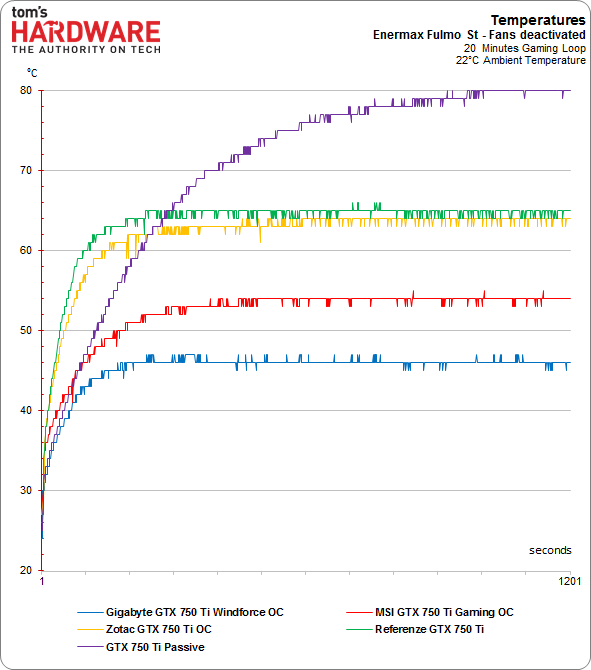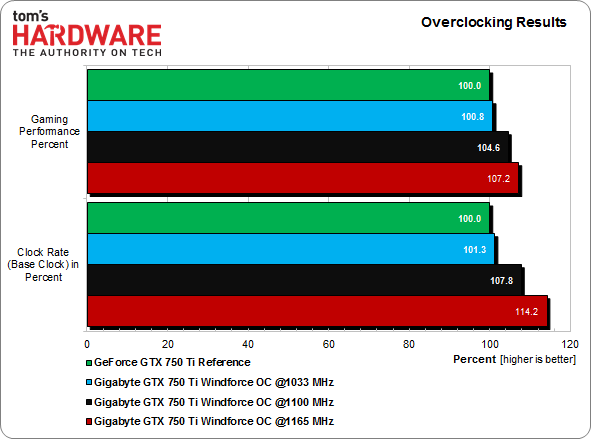Passively Cooling Nvidia's GeForce GTX 750 Ti...With An AMD Sink
We couldn't resist going where no man had before (or where no board partner could in time for Nvidia's launch): building a passively-cooled GeForce GTX 750 Ti. In the end, it took a bit of customization, since there aren't any compatible coolers yet.
Measurement Data And Performance
Temperature in a Closed Case
This heat sink's fin alignment is optimized for vertical operation, and it benefits from cases with some airflow. My idea here was to go completely noiseless. I wanted to test a true passive solution. So, we're once again using our Enermax Fulmo ST, testing in a closed case.
It takes just 20 minutes for the Maxwell-based GM107 to hit an 80 °C ceiling. Then, the chip gets some help from Nvidia's GPU Boost technology and its ability to back off clock rate to duck under certain power and thermal situations. Even the voltage regulators continue working within their specifications. Their roughly 93 degrees after an hour of work still falls within the safe zone.
Clock Rate And Throttling
Nvidia might not have been considering passive operation when it designed this card, but what we see from it (including GPU Boost performance) is still impressive.
What follows is a 40-minute loop of Metro: Last Light. Boost clocks do drop, but they also stabilize after the card hits its thermal target zone.
In the end, GPU Boost to around 1136 MHz, though as a percentage, performance drops more noticeably. Remember, the actively-cooled card reached a GPU Boost clock rate of 1162 MHz, occasionally dropping to 1150 MHz.
The base frequency of these cards doesn't change. You're guaranteed at least 1020 MHz, regardless of your cooling solution.
Our passively-cooled GeForce GTX 750 Ti loses about two percent of its performance compared to the reference model. To better hammer that point home, the aggressively cooled and factory-overclocked Gigabyte GTX 750 Ti Windforce OC achieved 1.3 percent-higher performance than the reference card. In the end, we're talking about about a three-percent performance loss in the quest for passive cooling.
Get Tom's Hardware's best news and in-depth reviews, straight to your inbox.
This is for Cautious People
If you're not willing to trust Nvidia's 80 °C temperature target (the company says 95 degrees is the GPU's thermal threshold), you can of course set a lower target of, say, 70 °C. That's going to give up a lot of performance though, and we're not sure such a compromise makes sense. At that point, you might as well buy a Radeon R7 250, which you don't have to build yourself. They already ship passively-cooled.
Current page: Measurement Data And Performance
Prev Page Overview Of The Finished Product Next Page Passive Cooling Works On GeForce GTX 750 Ti
Igor Wallossek wrote a wide variety of hardware articles for Tom's Hardware, with a strong focus on technical analysis and in-depth reviews. His contributions have spanned a broad spectrum of PC components, including GPUs, CPUs, workstations, and PC builds. His insightful articles provide readers with detailed knowledge to make informed decisions in the ever-evolving tech landscape
-
s3anister Excellent article; very unique take on what seems to be another future possibility for 750 Ti in the retail channel. I would have however, loved to see some thermals for the passively cooled card in a case like Fractal's Define R4 or Nanoxia's Deep Silence.Reply -
Cons29 i'm not comfortable with these temps, a low speed fan should be enough to lower it while still keeping the noise downReply -
FormatC The temperature target of 80°C was set by Nvidia for Kepler too - all reference boards were designed to handle this w/o problems.Reply -
emad_ramlawi interesting, i reckon it would been a perfect match for the GTX 750, i dont know why people overlook it, its only a tad slower than GTX 750 TiReply -
Blazer1985 False! The resistance generated the heat you had to dissipate, it was all but futile! :-D Sorry, nerd joke :-DReply -
de5_Roy very interesting little project. i read from reviews and comments how this gpu might be suitable for passive cooling. this may be the most powerful passively cooled card i've seen so far.Reply



